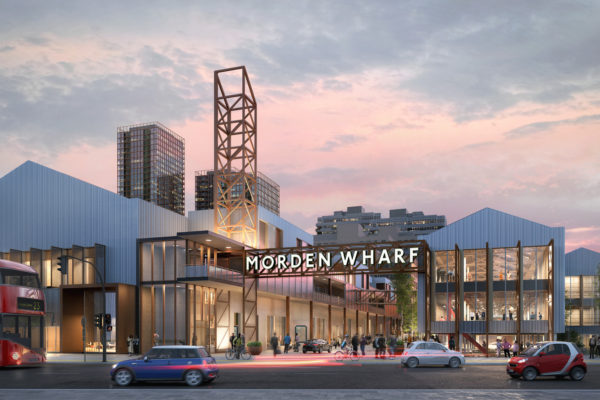We have been looking at new Industrial Intensification templates in response to the challenges facing retail, residential & logistics.
The Challenge
In the eyes of the retail, residential and logistics sectors, the last few years have been marked by a notable escalation in the debates surrounding the housing shortage crisis, the ever-increasing collapse of traditional retail practices, the challenges faced by supply chains and how these three issues subsequently intertwine.
The repurposing of industrial land to address the housing crisis has coincided with – and arguably sped up – the need to increase logistics storage to cope with the last-mile delivery requirements of new housing development ‘islands’. COVID-19 and the national lockdowns which ensued have only accelerated this process, boosting online retail and underlining the vital role of logistics in people’s day-to-day lives. In tandem with this process, high-street footfall has dramatically reduced as people’s shopping habits have changed, perhaps signalling the demise of not only the high street, but department stores and out-of-town centres too.


The Facts
The impact of the challenges faced by logistics supply and demand is apparent from the data; in November 2020, following the second lockdown, online retailing accounted for 31.4% of total retailing compared with 28.6% in October, with an overall growth of 74.7% in the value of online sales when compared to November of the previous year [ONS].
In addition to the rising star of online shopping, land supply is also posing a problem to logistics. In 2017, warehouse space in London was estimated to grow from 9.4 million to almost 13 million square feet in 2021 [P3 Logistics Parks and Cushman & Wakefield], but it has now been estimated that there is a shortfall of over 20.6 million square feet of warehouse space to support the new demands [Turley 2019]. According to data from Savills, last year 50 million square feet of warehouse space was let compared to just 37 million square feet the previous year, reducing the vacancy rate to 5.7% with only 3.5% of warehousing vacant in the South East. In addition to this, recent research indicates that for every £1 billion invested into UK manufacturing, an extra 175,000 square feet of warehouse space is needed to supplement it [Savills Logistics Spotlight event Jan 2021].


To complete this vicious almost self-fulfilling circle, much of the surplus brownfield land which could be used for industrial purposes is now in short supply as it has been released for residential purposes to reach the target of 300,000 new homes a year [Turley]. This process only serves to push industry further out of urban centres, creating even more pressure on supply and transportation infrastructure. In response to this, the Mayor of London, GLA and local London boroughs have implemented policies to protect Strategic Industrial Land (SIL).
However, this protection of SIL offers scope for a game-changing creative approach that will address not only commercial, but also community and environmental needs, whilst ensuring no net loss of precious industrial space. It is an approach supported by financial demand, with the increase in industrial land values outstripping other land uses, due to the competition between logistics and residential developers for land which is in short supply.
The Opportunity
What was previously accepted as a ‘lose-lose’ scenario for logistics, can now be completely turned around with the potential to benefit local communities, businesses, the environment and sustainability targets.
At Chetwoods, we caught sight early and anticipated that this combination of factors would create a rapidly rising requirement for logistics space and have already begun looking at solutions. These solutions, not only from the perspective of logistics, also overlap with the retail, residential and commercial sectors in which we have garnered a deep experience over many years of work.
From the 30 years we have been active in the industrial and logistics sector, Chetwoods are known as industry leaders. We design and deliver everything from single units to large multi-modal developments and have forged a considerable reputation for our research and development work in this area – specifically in providing logistics solutions.
For several years we have been exploring some exciting new concepts based around multi-storey warehouses and mixed-use urban logistics in our ‘Warehouses of the Future’ research programme. This has encompassed industry-wide ‘charettes’ – at home and abroad – looking at new innovative typologies. We have explored these new typologies through submissions for competitions: E-Hive2 was a concept for Property Week & Savills ‘Shed of the Future Last Mile Delivery’. It re-purposed a redundant urban multi-storey car park into a multi-purpose adaptable hub, combining everything from logistics solutions to residential units, retail and recreational and cultural and social spaces to put industrial and community at its heart.
The Well-Line (below) was our winning entry for the Royal Academy of Arts ‘Urban Jigsaw’ competition. The task was to develop speculative proposals for brownfield sites and underdeveloped spaces across London. Our solution was to repurpose the disused underground Post Office Railway. We proposed to transform London’s longest brownfield site, that runs for six miles from Paddington to Whitechapel, into a new high-tech logistics supply line to sustain the city by delivering goods and services from below.


The Way Forward
Recently, our research team have been looking at stakeholder and user requirements for logistics. We have conducted studies for the GLA on splitting up and tailoring a masterplan to suit its component communities, layering in new uses and co-locations. To accomplish this, we have used generic and bespoke tools and software to analyse different SIL types from multiple points of view, to gauge the practical, contextual and commercial potential for new multi-use combinations.
Using this research, our in-house design, sustainability and technology specialists have worked closely with our project teams to explore a range of different approaches to Industrial Intensification typologies and mixing different uses. These approaches are now coming through planning – or are even already under construction. This is truly a tribute to the enthusiastic buy-in of innovative clients, for whom we have already delivered innovation over many years and plan to deliver their next ‘first’, for many years to come.


U+I’s Morden Wharf (above), in London’s Docklands, displays industrial intensification on a site where the gateway to a new community is through SIL land. This exciting opportunity to create an urban fabric that integrates industrial logistics with residential is currently in planning.


The relocation of London’s wholesale food markets (above) – Smithfield, Billingsgate and New Spitalfields Markets – onto one SIL site, is bringing retail into industrial, while freeing up three central London sites to be repurposed into other use mixes.


GLP’s G-Park in London Docklands (above) – the UK’s first three-storey logistics facility – demonstrates how pure logistics space can be increased by using ramps to layer multi-level warehouses above ground. Our work here has caused us to be asked to look at several below-ground logistics sites in central London and its surrounding suburbs.
An industrial intensification scheme on a nearby GLA site involves industrial space being placed on top of logistics to encourage Small to Medium Enterprise (SME) business growth in the area. Other opportunities involve refurbishing old industrial heritage buildings to bring them back to life for modern day logistics and industrial use. There is a need for a new approach to logistics consolidation, with proposals for urban streets, areas and adjacent businesses to share consolidation centres on city outskirts to streamline multiple deliveries.
We are applying our experience in industrial intensification to retail sites too. We have been looking at how innovative architectural design can facilitate co-locating uses that repurpose retail in struggling high streets, department stores and shopping centres – a topic discussed in detail by Laurie Chetwood in his ‘Retail Rebooted’ presentation at the recent World Architecture Festival.
We focus strongly on sustainability measures and wellbeing facilities in our logistics work. With all new building stock needing to be Net Zero Carbon by 2030 and concerns about labour availability, the key drivers in logistics industry decision making have changed. At Savills recent Logistics Spotlight event, (in conjunction with Property Week & Tritax Symmetry) it was reported that the percentage of industry professionals who rate green features as important in warehouse decision making has increased from 51.4% in 2017 to 67% in 2020 [Analytiqa Logistics Spotlight]. In the same survey, over three-quarters of retailers and more than 70% of logistics companies claimed to offer wellness programmes to warehouse staff.
We will be covering some of these themes, including designing for the WELL Standard, Net Zero Carbon Construction, Digital Twins and ESG in more detail in future posts.
Tim Ward, Managing Director, Chetwoods
To be the first to receive our latest research, industry articles, event invitations or news updates, please provide your details below to subscribe. You can unsubscribe at any time.






